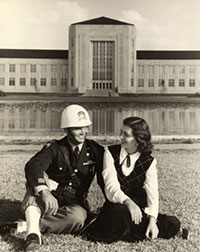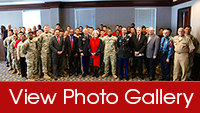News & Events
Legendary Cullen Rifles competition rifle team returns to campus
Alumna Lillie Robertson makes gift to reestablish Army ROTC target shooting club

A man in a Cullen Rifles uniform sits with a woman in front of the Ezekiel Cullen Building in 1950. The Cullen Rifles were a drill team that preformed at home and away football games.
The Cullen Rifles, a competition shooting and drill team, was founded at the University of Houston in the 1940s and disbanded in the 1980s.
On September 27, the Cullen Rifles unit was resurrected by the University of Houston Battalion of the Army Reserved Officers Training Corps thanks to a generous donation by alumna Lillie Robertson.
“The Cullen Rifles combines not only the traditions and character of ROTC, but it steps things up to another level of excellence,” said Robertson, a granddaughter of UH founder Ezekiel Cullen.
She said her gift honored her grandfather’s commitment and involvement in the Cullen Rifles and her father’s service in the Air Force during World War II as a B-17 pilot.
The legacy of the Cullen Rifles is rich and entwined with the history of the University of Houston. The unit served as the color guard for President Eisenhower when he visited campus during his presidency. The squad was ranked No. 1 in the nation in 1967 and 1971. Among its former members are two All-Americans – Jesse Reynolds in 1966 and Senold Legge in 1972 and 1973.
“We’re pleased to have the Cullen Rifles return to campus and we know they will once again restore the glory that they once represented for the University of Houston,” said Dean John W. Roberts.
He and Ms. Robertson spoke on September 27 at the official ceremony welcoming back the Cullen Rifles to campus. At that event, UH Army ROTC Battalion Commander Lieutenant Colonel Michael Smith said the reestablishment of the Cullen Rifles kicks off a new expansion phase for the UH Battalion.
“The University of Houston has been designated as one of the seven “growth schools” in the nation and that means our mandate is to grow,” he said.
The Battalion is headquartered at UH but it is responsible for several Houston- area colleges. Last year, there were 80 Army ROTC cadets throughout the Houston area. This year the Battalion has about 120 cadets. It’s goal is to increase that number to between 220 and 250 cadet by 2015.
“How we’re going to do that is by retaining quality high school students in Houston and we want them to come here to the University of Houston and the Cullen Rifles will help them to do that,” he said.
Students seek out Reserved Officers Training Corps (ROTC) programs on college campuses for many reasons. Chief among them are a desire to serve the nation, a chance to graduate from college debt free with a job, an interest in developing new leadership skills, and a commitment to train for and master physical endurance challenges.
The Army ROTC has everything students need to achieve those goals. But last year, the LTC Smith decided the Corps was missing a key recruiting and retention tool – a competition rifle team.
Rifle marksmanship is a foundational military skill. Every soldier is tested on his or her ability to hit a target. But marksmanship is also a sport with national championships hosted by the National Collegiate Athletic Association and worldwide championships hosted by the International Olympic Committee. Like crew and archery, it’s one of a few Olympic-sanctioned sports that young adults can begin pursuing in college.
In Texas, Texas Christian University and Texas A&M University have NCAA competition rifle teams that attract some of the best sharp shooters in the nation. And in NCAA tournaments, women and men compete against each other. The reigning national champion is a woman at West Virginia University, a program that has won 15 national championships. The 2014 tournament will be held March 14 -15.
LTC Smith invited rifle Olympic gold medalist Staff Sgt. Glenn Eller to speak at the Cullen Rifles ceremony. A native of Katy, SSG Eller competed in the last four Olympics as a member of the U.S. national team. He said that he had his most success in his third appearance in the global competition after he joined the Army and began training with its competition rifle team.
